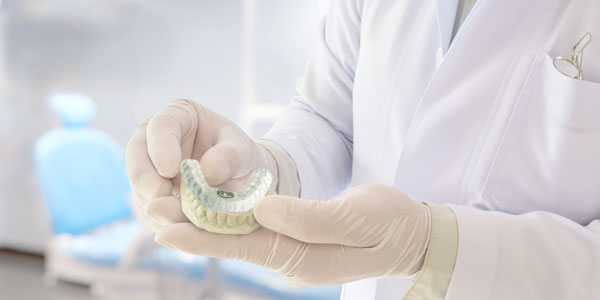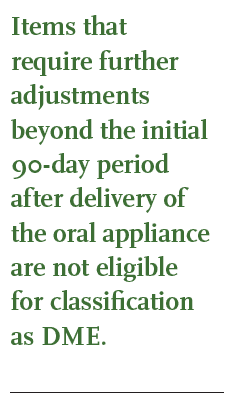
by Jayme R. Matchinski, Esq.
Oral Appliance Therapy is recognized as an effective and efficient treatment for snoring and Obstructive Sleep Apnea (OSA) and the management of other sleep-related breathing disorders. Oral appliances are custom fit by dentists for patients to improve the patient’s sleep and address and treat any issues the patient is experiencing as a result of OSA.
Oral Appliances have historically been seen as an alternative to the provision of CPAP; however, issues related to the use of CPAP, including the patient’s intolerance to air pressure, difficulty with mask fitting, maintenance of the CPAP machine, non-adherence to CPAP treatment within several months of initiating treatment, and availability of electricity for the operation of CPAP, have caused the prescription and usage of Oral Appliances to increase and become widely accepted as a non-invasive treatment that effectively treats the patient’s snoring, OSA, or other sleep-related breathing disorders.
Depending upon whether a patient has a commercial health insurance plan or is a beneficiary of a government program, including Medicare and/or Medicaid, there are different coverage guidelines and regulations governing the provision of Oral Appliances and reimbursement by third party payors. This article will provide an overview of the key regulatory issues related to provision Oral Appliances that dentists and dental practices should consider prior to billing for Oral Appliances.
Oral Appliance Coverage and Coding Guidelines
The Medicare Enrollment Application – Durable Medical Equipment, Prosthetics, Orthotics, and Supplies (DMEPOS), CMS-855S, must be submitted by a dentist or dental practice to CMS to become a licensed DME supplier. For a dentist or dental practice to receive reimbursement from Medicare or to bill Medicare for an Oral Appliance, the treating dentist must enroll her practice location as a Medicare DME Supplier.
The Local Coverage Determinations (LCDs) for Oral Appliances for Obstructive Sleep Apnea (L28601, L28603, L28606, and L28620) have been combined into LCD L33611, with an effective date of October 1, 2015, and a revision effective date of January 1, 2019. These LCDs set forth the conditions for Medicare coverage and reimbursement, and the LCDs state that the Medicare Program will pay for the Oral Appliance only if the patient has a positive diagnosis of OSA as determined by a Medicare-covered sleep test. Specifically, a custom fabricated mandibular advancement Oral Appliance (E0486) used to treat OSA is covered if the following criteria are met:
B. The beneficiary has a Medicare-covered sleep test that meets one of the following criteria (1 – 3):
2. The AHI or RDI is greater than or equal to 5 and less than or equal to 14 events per hour with a minimum of 10 events and documentation of:
b. Hypertension, ischemic heart disease, or history of stroke; or,
b. The treating physician determines that the use of a PAP device is contraindicated.
D. The device is provided and billed for by a licensed dentist.
The LCDs specify the conditions that determine whether the item or service is reasonable and medically necessary and the related policy articles detail the requirements that must be met for an Oral Appliance to be classified as DME and coded as E0486.
The term “durable medical equipment” is defined in Section 1861(n) of the Social Security Act as equipment furnished by a DMEPOS supplier that is:
- Able to withstand repeated use;
- Effective with respect to items classified as DME after January 1, 2012, has an expected life of at least 3 years;
- Primarily and customarily used to serve a medical purpose;
- Generally not useful to an individual in the absence of an illness or injury; and
- Appropriate for use in the home.
 Code E0486 may only be used for custom-fabricated mandibular advancement devices. Specifically, only Oral Appliances that have undergone coding verification review by the PDAC Contractor are eligible for Medicare reimbursement. To qualify for reimbursement, the Oral Appliance must fulfill all criteria specified in the durable medical equipment definition, the Oral Appliance Therapy must be necessary and reasonable for the treatment of OSA, and all other billing coding and documentation requirements must be met.
Code E0486 may only be used for custom-fabricated mandibular advancement devices. Specifically, only Oral Appliances that have undergone coding verification review by the PDAC Contractor are eligible for Medicare reimbursement. To qualify for reimbursement, the Oral Appliance must fulfill all criteria specified in the durable medical equipment definition, the Oral Appliance Therapy must be necessary and reasonable for the treatment of OSA, and all other billing coding and documentation requirements must be met.
To be coded as E0486, custom-fabricated mandibular advancement devices must meet all of the following criteria:
- Have a fixed mechanical hinge at the sides, front or palate;
- Have a mechanism that allows the mandible to be advanced by the patient in increments of one millimeter or less;
- Be able to protrude the mandible beyond front teeth when adjusted to maximum protrusion;
- Retain the adjustment setting when removed from the mouth;
- Maintain the adjusted mouth position during sleep;
- Remain fixed in place during sleep so as to prevent dislodging the device; and,
- Require no return dental visits beyond the initial 90-day fitting and adjustment period to perform ongoing modification and adjustments in order to maintain effectiveness.
Items that require further adjustments beyond the initial 90-day period after delivery of the oral appliance are not eligible for classification as DME. These items are considered dental therapies, which are not eligible for reimbursement by Medicare under the DME coverage guidelines, and cannot be coded using E0486.
Billing for Oral Appliance Therapy is all inclusive. The lump sum payment derived from the DMEPOS Fee Schedule includes: all time, labor, materials, professional services, radiology and laboratory costs incurred in fabricating and fitting the device, as well as adjustment and professional services required during the 90 days following the initial placement. The reimbursement is payable only by the regional DME MAC, not the Part B local carrier. Medicare claims related to the fitting, initial/subsequent adjustments and repairs of an Oral Appliance should be submitted to the appropriate DME MAC and not as evaluation and management (E/M) services to the A/B MAC. Additionally, any radiological or other services performed in order to guide the adjustments of the oral device should not be submitted separately to the A/B MAC, as the Medicare payment associated with Healthcare Common Procedure Coding System (HCPCS) code.
 E0486 includes any required adjustments to ensure a properly fitted device, and services related to the E0486 code, including: initial patient evaluation, any required imaging, all fitting and post fabrication adjustments, are contained in the code and payable only by the DME MAC. The HCPCS encompasses both billable and payable codes. A billable HCPCS code is one that is submitted on a claim to the DME MAC. A payable HCPCS code is one that is considered for payment by the DME MAC only if the item meets the definition of durable medical equipment, falls under a statutory benefit category, and meets all other statutory and regulatory requirements.
E0486 includes any required adjustments to ensure a properly fitted device, and services related to the E0486 code, including: initial patient evaluation, any required imaging, all fitting and post fabrication adjustments, are contained in the code and payable only by the DME MAC. The HCPCS encompasses both billable and payable codes. A billable HCPCS code is one that is submitted on a claim to the DME MAC. A payable HCPCS code is one that is considered for payment by the DME MAC only if the item meets the definition of durable medical equipment, falls under a statutory benefit category, and meets all other statutory and regulatory requirements.
Documentation Requirements
Dental practices, as DMEPOS suppliers, must have a written order on file from the treating physician before dispensing an Oral Appliance to a Medicare beneficiary. Dentists may not generate the written order for Oral Appliance Therapy themselves since they are not licensed to perform and interpret sleep tests and diagnose OSA.
The written order must contain the beneficiary’s name, physician’s name, legible signature and signature date, date of the order, and detailed description of the item. The detailed description in the written order may be either a narrative description or a brand name/model number. Written orders may take the form of a photocopy, facsimile image, electronically maintained, or original pen-and-ink document. Signature and date stamps are not allowed. Signatures must comply with the CMS signature requirements.
The written order must be maintained in the dentist’s files for seven (7) years and available to Medicare contractors upon request. If the dentist does not have a signed order before submission of the claim for Medicare payment, the claim will be denied.
Additionally, for DMEPOS items to be covered by Medicare, the medical record must contain sufficient documentation of the medical condition to substantiate medical necessity for the item ordered. Section 1833(e) of the Social Security Act precludes payment to any service provider unless “there has been furnished such information as may be necessary in order to determine the amounts due such provider.”
Since physicians are tasked with diagnosing and treating the Medicare beneficiaries, dentists and dental practices must obtain from them copies of the treating physician’s notes, pertinent test reports, and other health care records to substantiate the reasonableness and medical necessity for the Oral Appliance ordered. The DME MAC may request this information in selected cases from the physician and/or dentist or dental practice.
If the DME MAC does not receive the information when requested or if the information in the patient’s medical record does not adequately support the medical necessity for the item, then on the assigned claims, the dentist may be liable for the dollar amount involved unless a properly executed advance beneficiary notice (ABN) of possible denial has been obtained.
To meet the Medicare coverage guidelines and reimbursement requirements, the information in the medical record should include evidence that the treating physician conducted a face-to-face clinical evaluation prior to the sleep study to assess the patient for OSA. The clinical evaluation should be documented in a detailed narrative note in the patient’s chart in the format that the physician uses for other entries. At a minimum, the clinical evaluation should include the following information:
- Patient’s Medical History,
- Signs and symptoms of sleep disordered breathing including snoring, daytime sleepiness, observed apneas, choking or gasping during sleep, morning headaches,
- Duration of symptoms,
- Validated sleep hygiene inventory such as the Epworth Sleepiness Scale,
- Physical examination,
- Body mass index,
- Neck circumference; and
- Focused cardiopulmonary and upper airway evaluation.
The information in the medical record should include the patient’s diagnosis and other pertinent information including, but not limited to, duration of the patient’s condition, clinical course, prognosis, and therapeutic interventions and results. Neither the physician’s order, a supplier’s prepared statement nor a physician’s attestation by itself, provides sufficient documentation of medical necessity, even though signed by the treating physician or supplier. There must be information in the patient’s medical record to substantiate the information in these documents. Moreover, the patient’s medical record is not limited to the physician’s office records but may also include hospital, nursing home, or home health agency records and records from other health care professionals. Once the Oral Appliance is custom fabricated and delivered to the patient, the dentist and/or dental practice is required to maintain proof of delivery documentation.
The Medicare coverage guidelines and documentation requirements continue to evolve and change, and well as reimbursement requirements by other third party payors, including commercial insurance companies. Enforcement and recoupment efforts by third party payors related to the provision of Oral Appliances have also intensified, and dentists and dental practices must stay tuned to any regulatory changes which impact the provision of Oral Appliances in order to ensure regulatory compliance and receipt of reimbursement for such Oral Appliances.



